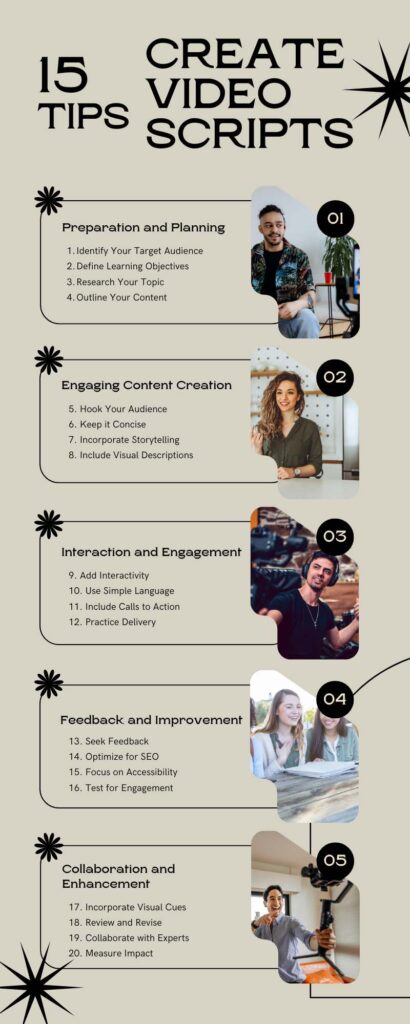Views: 0
Creating compelling and informative video content is key to engaging learners and enhancing their learning experience.

A crucial aspect of crafting impactful online classes is to develop well-structured video scripts that sparks curiosity and inspire students.
In this list of tips, we break down the art of developing video scripts for online classes.
Our goal is to offer valuable insight and practical tips to help educators create engaging and effective content that audience will want more of.
- Understanding Your Audience: The first step in developing a video script for online classes is understanding your target audience. By knowing who your learners are, their preferences, and their learning needs, you can tailor your script to resonate with them and enhance engagement.
- Setting Clear Learning Objectives: Clearly defining the learning objectives of your online class is essential in guiding the content of your video script. By outlining the goals and outcomes you aim to achieve, you can structure your script to effectively deliver the intended message to learners.
- Thorough Research: Conducting in-depth research on the topic of your online class is crucial for creating a well-informed and accurate video script. By ensuring the content is relevant, informative, and up-to-date, you can provide valuable insights to your audience.
- Crafting a Structured Outline: Organizing your video script with a structured outline helps ensure a cohesive presentation that flows smoothly from one point to the next. By outlining key points, transitions, and visual elements, you can create a clear and engaging learning experience for viewers.
- Captivating Your Audience: Starting your video script with a compelling hook or question is essential for grabbing viewers’ attention from the beginning. By engaging your audience right from the start, you set the tone for an immersive and captivating learning experience.
- Clarity and Conciseness: Keeping your script clear, concise, and focused on delivering value is key to ensuring that learners can easily understand and retain the information presented. Avoiding unnecessary details and jargon helps maintain engagement throughout the video.
- The Power of Storytelling: Incorporating storytelling elements into your video script can make the content more relatable, engaging, and memorable for viewers. By weaving narratives or real-life examples into your script, you can create an emotional connection with your audience and enhance their learning experience.
- Visual Enhancements: Describing visuals or graphics that complement your script can help reinforce key concepts and enhance understanding for viewers. By incorporating visual cues into your video content, you can create a more engaging and interactive learning experience.
- Interactive Elements: Adding interactive elements such as quizzes, polls, or activities to your video script can increase viewer engagement and participation. By encouraging learners to actively interact with the content, you create a more dynamic and immersive learning environment.
- Calls to Action: Including clear calls to action at strategic points in your video script encourages viewers to take specific actions after watching the content. Whether it’s subscribing to a channel, visiting a website, or completing an assignment, CTAs (Call to Action) guide learners on their educational journey and promote engagement.
- Practice Makes Perfect: Rehearsing your script aloud multiple times before filming ensures a smooth delivery and natural flow during recording. Practicing your delivery helps you become more comfortable with the content and improves your on-screen presence.
- Feedback and Collaboration: Seeking feedback from peers or mentors on your video script can provide valuable insights for refinement and improvement. Collaborating with subject matter experts or instructional designers can also help ensure the accuracy and quality of your content.
- Optimizing for SEO: Including relevant keywords and phrases in your video script can improve search engine visibility and attract organic traffic to your online classes. By optimizing your content for SEO, you can reach a wider audience and increase exposure for your educational offerings.
- Accessibility Considerations: Ensuring that your video script is accessible to all learners, including those with visual or hearing impairments, is essential in creating an inclusive learning environment. By considering accessibility features in your script, you make education more accessible to diverse audiences.
- Continuous Improvement: Continuously reviewing and revising your video script based on feedback and analytics helps enhance its effectiveness over time. Monitoring metrics such as viewer engagement, completion rates, and student feedback allows you to evaluate the impact of your content on learning outcomes.
By mastering the art of developing video scripts for online classes, educators can create engaging, informative, and impactful content that resonates with learners and inspires them on their educational journey.
With careful planning, creativity, and attention to detail, crafting compelling video scripts can transform online classes into immersive learning experiences that leave a lasting impression on students.
If you’re looking to enhance your online classes with engaging video content and well-crafted scripts, contact us today to learn more about our services and how we can support you in creating dynamic educational experiences that captivate learners and drive success in online education.
Let’s start your innovation and excellence together!


Leave a Reply
You must be logged in to post a comment.